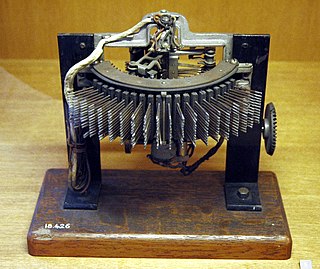
Dual-tone multi-frequency signaling (DTMF) is a telecommunication signaling system using the voice-frequency band over telephone lines between telephone equipment and other communications devices and switching centers. DTMF was first developed in the Bell System in the United States, and became known under the trademark Touch-Tone for use in push-button telephones supplied to telephone customers, starting in 1963. DTMF is standardized as ITU-T Recommendation Q.23. It is also known in the UK as MF4.

A telephone card, calling card or phonecard for short, is a credit card size plastic or paper card, used to pay for telephone services. It is not necessary to have the physical card except with a stored-value system; knowledge of the access telephone number to dial and the PIN is sufficient. Standard cards which can be purchased and used without any sort of account facility give a fixed amount of credit and are discarded when used up; rechargeable cards can be topped up, or collect payment in arrears. The system for payment and the way in which the card is used to place a telephone call vary from card to card.

A rotary dial is a component of a telephone or a telephone switchboard that implements a signaling technology in telecommunications known as pulse dialing. It is used when initiating a telephone call to transmit the destination telephone number to a telephone exchange.

A telephone switchboard is a telecommunications system used in the public switched telephone network or in enterprises to interconnect circuits of telephones to establish telephone calls between the subscribers or users, or between other exchanges. The switchboard was an essential component of a manual telephone exchange, and was operated by switchboard operators who used electrical cords or switches to establish the connections.
In telecommunication, an automatic callback is a computer telephony calling feature that permits a user, when encountering a busy condition or other condition where the called individual is unavailable, to instruct the system to retain the called number and to establish the call when there is an available line or when the called number is no longer busy. Automatic callback may be implemented in the terminal, in the telephone exchange, or shared between them. Automatic callback is not the same as camp-on.

Pulse dialing is a signaling technology in telecommunications in which a direct current local loop circuit is interrupted according to a defined coding system for each signal transmitted, usually a digit. This lends the method the often used name loop disconnect dialing. In the most common variant of pulse dialing, decadic dialing, each of the ten Arabic numerals are encoded in a sequence of up to ten pulses. The most common version decodes the digits 1 through 9, as one to nine pulses, respectively, and the digit 0 as ten pulses. Historically, the most common device to produce such pulse trains is the rotary dial of the telephone, lending the technology another name, rotary dialing.

A hotline is a point-to-point communications link in which a call is automatically directed to the preselected destination without any additional action by the user when the end instrument goes off-hook. An example would be a phone that automatically connects to emergency services on picking up the receiver. Therefore, dedicated hotline phones do not need a rotary dial or keypad. A hotline can also be called an automatic signaling, ringdown, or off-hook service.
In telephony, ringdown is a method of signaling an operator in which telephone ringing current is sent over the line to operate a lamp or cause the operation of a self-locking relay known as a drop.

In many countries the public switched telephone network has a single emergency telephone number that allows a caller to contact local emergency services for assistance. The emergency number differs from country to country; it is typically a three-digit number so that it can be easily remembered and dialed quickly. Some countries have a different emergency number for each of the different emergency services; these often differ only by the last digit. See List of emergency telephone numbers.

The Strowger switch is the first commercially successful electromechanical stepping switch telephone exchange system. It was developed by the Strowger Automatic Telephone Exchange Company founded in 1891 by Almon Brown Strowger. Because of its operational characteristics it is also known as a step-by-step (SXS) switch.
A dialer or dialler is an electronic device that is connected to a telephone line to monitor the dialed numbers and alter them to seamlessly provide services that otherwise require lengthy National or International access codes to be dialed. A dialer automatically inserts and modifies the numbers depending on the time of day, country or area code dialed, allowing the user to subscribe to the service providers who offer the best rates. For example, a dialer could be programmed to use one service provider for international calls and another for cellular calls. This process is known as prefix insertion or least cost routing. A line powered dialer does not need any external power but instead takes the power it needs from the telephone line.
Operator assistance refers to a telephone call in which the calling party requires an operator to provide some form of assistance in completing the call. This may include telephone calls made from pay phones, calls placed station-to-station, person-to-person, collect, third number calls, calls billed to a credit card, and certain international calls which cannot be dialed directly. The telephone operator may also be able to assist with determining what kind of technical difficulties are occurring on a phone line, to verify whether a line is busy, or left off the hook, and break in on a phone line to request for the caller to clear the line for an incoming call. The latter service is often utilized by emergency police. In addition, operators are often a first point of contact for the elderly wanting information on the current date and time.

A telephone call is a connection over a telephone network between the called party and the calling party.
A telephone numbering plan is a type of numbering scheme used in telecommunication to assign telephone numbers to subscriber telephones or other telephony endpoints. Telephone numbers are the addresses of participants in a telephone network, reachable by a system of destination code routing. Telephone numbering plans are defined in each of administrative regions of the public switched telephone network (PSTN) and they are also present in private telephone networks. For public number systems, geographic location plays a role in the sequence of numbers assigned to each telephone subscriber.

A business telephone system is a multiline telephone system typically used in business environments, encompassing systems ranging from the small key telephone system (KTS) to the large private branch exchange (PBX).
In telecommunications, a long-distance call (U.S.) or trunk call (U.K.) is a telephone call made to a location outside a defined local calling area. Long-distance calls are typically charged a higher billing rate than local calls. The term is not necessarily synonymous with placing calls to another telephone area code.

The push-button telephone is a telephone that has buttons or keys for dialing a telephone number, in contrast to having a rotary dial as in earlier telephone instruments.













